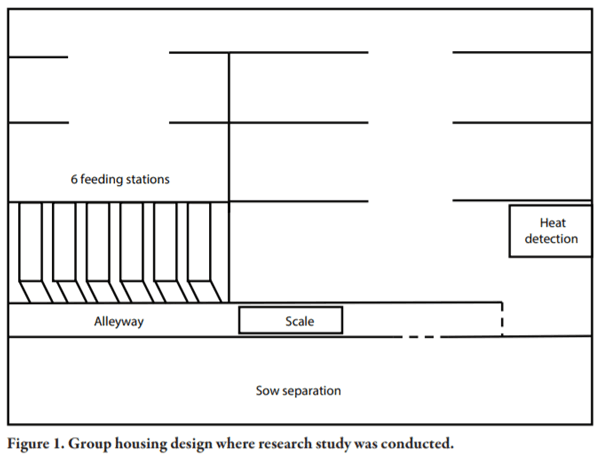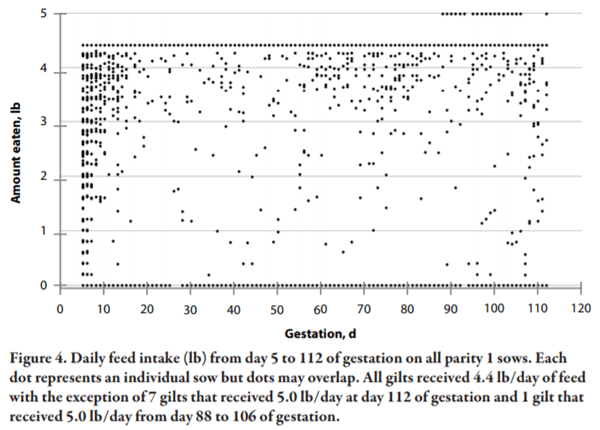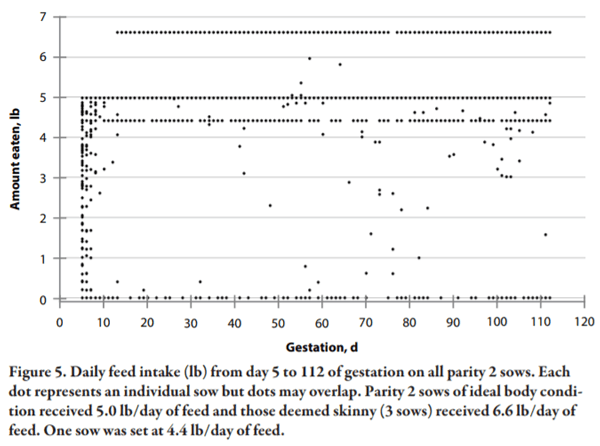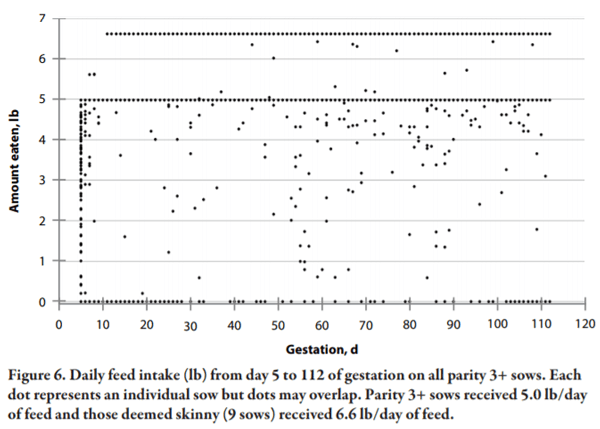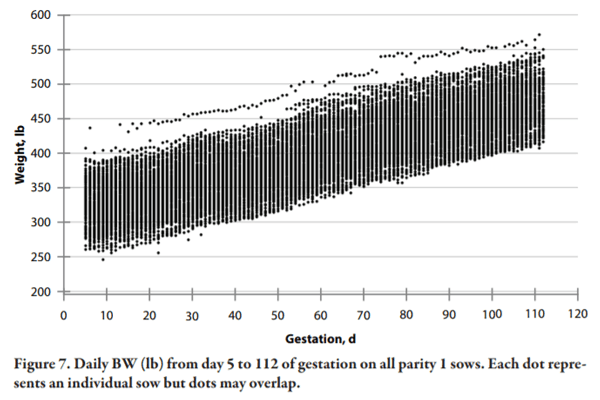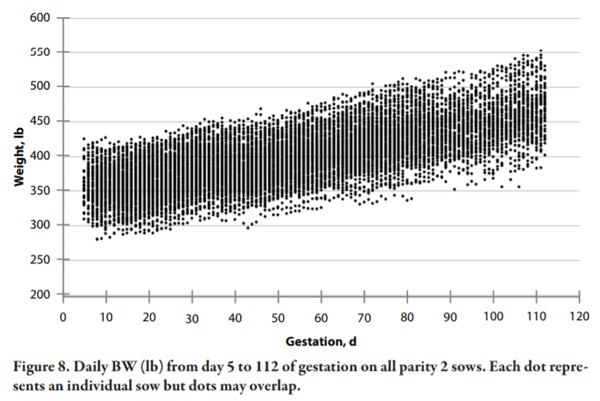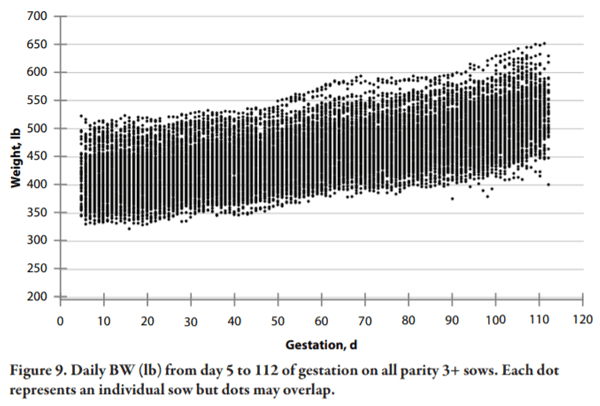Introduction
As many production systems are transitioning from individual gestation stalls to different styles of group housing, there are new challenges for data collection in the gestation barn. Commonly referred to as electronic sow feeders (ESF), computerized feeding stations have been available for more than 30 years as a method used to control the variability of sow intake (Trottier and Johnston, 2001), and now are becoming a powerful tool for sow research.
Electronic sow feeders typically have single enclosed feeding stations that can feed up to 60 group-housed sows per station. The stations are equipped with computers that track and dispense feed for each sow as she moves through the feeding station. The sows each have an ear tag that contains a radio frequency identification (RFID) transponder that identifies the specific sow to the system. This type of system is appealing to producers as it allows them to feed sows as individuals while in a group-housed setting. Electronic sow feeders are appealing to researchers because individual feed intakes can be recorded in some of these systems. This creates numerous research opportunities.
A research study was conducted on a commercial sow farm in central Nebraska, where sows were group-housed with ESF. Before leaving the feeding station and returning to the pen, sows walked over a scale where daily weights were collected. Following the completion of the study, 663,204 weight and 74,114 intake observations were recorded. Thus, data collection, and management were each crucial processes in making this study a success. Many lessons were learned along the way from managing ESF and sow body weight data. Therefore, the first objective of this review is to outline problems that emerged when collecting ESF and sow body data. The second objective is to better understand the intake patterns observed in grouped housed sows with ESF.
Procedures
Group-Housing System
Sows (Line 1050, PIC, Hendersonville, TN) were group-housed (approximately 260 sows per pen) from d 4 to 112 of gestation in dynamic groups (Figure 1). Each pen was equipped with 6 electronic feeding stations (NEDAP, The Netherlands) allowing for 45 sows per station. Pens also included a pen with a boar for automated heat detection and a holding area for sow separation. Heat detection is a separate station that automatically recognizes, marks, and separates sows based on heat. The sow separation system recognizes the right animals to be separated and automatically leads them to the holding area. In 3 selected pens, 1 scale (84” long × 20” wide; New Standard US Inc., Sioux Falls, South Dakota) was added to the alleyway following the individual feeding stations leading to the pen. The prototype scale would automatically collect sow weights through the attached antenna that would read the sow’s RFID tag, similar to the ESF. Weights were recorded as the sow placed her hind legs on the platform.
Data Collection
Daily feed intakes were manually extracted through NEDAP software. The software didn’t have long-term storage and if feed intakes were not extracted daily those intakes would be deleted. The feeding system reset at 2:00 p.m. daily, therefore intakes had to be downloaded prior to this time. The closer intake was downloaded to system reset, the more intakes were recorded. There were only 13 of 149 d when intake data were not downloaded successfully due to unknown system errors. The system appeared to be downloading but when users tried to retrieve the file, no data were found. Attempts were made to retrieve the data again, however, downloads were performed at 1:00 p.m., and most data could not be retrieved before system reset. Feeding stations were calibrated once weekly following standard farm procedures.
After 5 days of downloading intake data, values of 0 were observed for intake. Our concern was how could a sow have an intake of 0 if she walks through the feeding station? We were assuming that when her RFID was read, feed would be dispensed. After further investigation, we learned that there was one antenna in the feeding station, located at the feeder. A sow may enter the feeding station if the gate is unlocked. The gate is unlocked when the station is not occupied or if the sow within the station has already received her daily allowance of feed. When the sow enters into the station and gets her head close enough to the feeder or in the feeder to be read by the antenna, feed will be dispensed. However, if the sow doesn’t remain in this area and leaves the feeding station, feed will not be dispensed. Thus, values of zero for feed intake may be recorded.
Weights were automatically recorded and stored in the system software by day for multiple weeks at a time. A total of 8 of 149 d of weights were not extracted for specific pens due to human error (computer chips were dropped in the pit or not cleared properly). The scales were calibrated every week during the time of feed calibration.
Sows had to walk across the scale as they moved from the feeding station and back into the pen. There was great variability in the weights being generated on a single day for individual sows. This forced us to pay close attention to how sows moved across the scale and determine a method that could be used to eliminate inaccurate weights.
In many cases, more than one sow was on the scale at a time. The sow in front had two front legs off the scale while the sow behind her only had her two front legs on the scale. During times of activity (feed calibration, reset of feeding stations, workers in the pen, etc.) feeding stations were almost always occupied by sows that already received their daily allowance of feed. This increased traffic through the alleyway causing sows to move quickly across the scale. There was discussion of adding a panel to the front of the scale to possibly slow the sows down during these times, however; some feared this might cause them to move too slowly and cause an unhealthy environment for the sows.
As a sow moves across the scale, the antenna reads the RFID and continues to record weights until the next responder tag is read. Younger sows and gilts, who were not as long as older sows, would be standing on the back end of the scale but not far enough forward for the antenna to read the RFID. Thus, these weights were recorded on the previous sow. The antenna was adjusted forward in attempt to account for this, which improved readings.
The antenna on the scale was able to read through the panels of the scale and if a sow were lying on the opposite side of the scale, in the pen, her RFID would be read. However, once another sow was on the scale (in a position close enough to the antenna), her RFID was read and recorded properly. In addition, if a sow in the pen was lying against the panel adjacent to the scale, this impacted the accuracy of weights. The impact was greatest when multiple animals were nesting in this area. To prevent this and the previous concern from occurring, sternum bars can be added to the pen to prevent sows from lying or nesting in this area.
The scale system generated a score that indicated the number of consecutive stable measurements (1 point per measurement, 1 measurement per 250 ms). A high score was thought to generate a more credible weight; however, using this method to determine accuracy in weights was not successful because we had no way of knowing if all 4 feet were on the scale. The score may have been high indicating she was stable on the scale for a long period of time but she may have only been half way on the scale.
Each of these uncertainties contributed to the variability in daily weight collection. Therefore, manual weights were collected on all sows at the beginning and end of gestation. These weights were then used to eliminate inaccurate weights in the data set based on predicted gains.
Data Management
During collection of these data, it became obvious that good data management would be imperative to properly analyze the large data set. Preparing data for analysis in addition to determining a method to accurately and confidently eliminate faulty sow weights from the data set was a major concern.
Through trial and error, it was determined advantageous to keep all data sets separate. Combining data within Excel is not recommended due to the size of these data sets and the risk of losing data. Handling each data set individually and then carefully merging them with statistical software proved to be most successful. It is important to note that there are cases when intakes and weights are missing for multiple days of gestation. In these cases, the intake data provide parity, and day of gestation. Thus if a sow did not eat, this information for that particular day of gestation would not be recorded. This presented challenges when attempting to model the data. Creating a spreadsheet that contained the sow identification number, parity, and date for d 4 to 112 of gestation eliminated this problem. This spreadsheet was then merged with the intake data file for all sows to have intake data for every day from d 4 to 112 of gestation.
Before merging the weights with the remaining data, it was necessary to eliminate incorrect weights from the data set. For this process, reference weights were collected and the following steps were applied to the data set to eliminate inaccurate weights.
- If the recorded weight was less than 220.5 lb (100 kg), the value was deleted as it was assumed to be inaccurate. The 100 kg minimum weight was selected as being well below the minimum weight for replacement gilts. Trottier and Johnston reported in 2001 that a target weight range of 245 to 265 lb at mating on second estrus was reasonable in gilts. PIC currently recommends the ideal live weight at first service to be 300 to 320 lb.
- Average daily gain (ADG) was calculated from the two reference weights for each sow.
ADG = (Weight 2 - Weight 1) / (Date 2 - Date 1)
- Using ADG, a predicted weight was calculated based on the initial known weight and day of gestation.
Predicted weight = (Weight 1 + (ADG * d)); where (d) is calculated as the difference in days between the actual weight and the reference weight.
- The ratio of predicted weight to the actual weight was determined and if the actual weight was 5% above or below the predicted weight, the weight was deleted (Figure 2).
Ratio = Predicted weight / Actual weight
Following these steps, the weight data set was reduced from 663,204 to 160,405 observations. The elimination of 502,799 observations reinforces the great variability in sow weights and how most of these weights were inaccurate.
In addition to these calculations, time adjustments were made to the weight data set. The ESF system resets at 2:00 p.m. daily and therefore the dates and times recorded for the weights did not correspond to the dates and times recorded for the intakes. Using the recorded times of data collection, data sets were adjusted to the same time of day, eliminating the problem.
A total of 135 sows were removed from the study. Of these sows, 40 were removed due to death or culling decisions by the farm. The remaining sows were removed based on missing intake values (greater than 3 consecutive days). Recall, errors occurred during download for feed intakes on 13 days. We assume the sows still consumed their daily feed allowance on each of these days and thus, replaced these missing values. After doing this, we removed sows who missed greater than 3 consecutive days of intake, indicating she has been removed from the pen. Sows were removed from the pen primarily for lameness or illness. In some cases, the sow returned to the pen later in gestation but we were unable to track her intake outside of the pen, thus these animals were removed from the study.
Data Analysis
At the conclusion of this trial, files containing weights, intakes, progeny data, and backfat measurements were merged to create a master file containing 194,162 observations with 37 variables. With the help of statistical software, it becomes relatively simple to analyze any of the 37 variables. Some variables were common among the files (RFID) and were combined as they were merged; however, many were different, thus contributing to the large number of variables in the final data set (initial backfat, total born, etc.) We were not only able to analyze the data for the purpose of which this study was conducted, but also analyze the behavior of these animals in this production system.
Most producers would agree that when operating with an ESF, getting the animals acquainted with the system and on full feed can be a challenge. It is becoming common practice for producers with ESF to develop gilt training programs. Some programs are more elaborate than others but the goal is to teach the gilt or sow how to use the system. Gilts are unfamiliar with the equipment and can be reluctant to enter or remain in the station and, thus, not eat. Reduced feed intake in gestation is a large concern for producers, thus maintaining the set feed intake is important.
In this system, gilts receive two weeks of extensive training prior to breeding and placement in gestation group housing. Prior to this training, gilts become familiar with the ESF system as they move through the nursery and the gilt development unit, through the use of pre-training practices (enclosed electronic scale and one-way gates). Gilts and sows were added to the pen 4 d post breeding and remained there until d 112 of gestation. Gilts and sows received 4.4 and 5.0 lb/d of feed while animals deemed as skinny, based on body condition scores evaluated by the farm employee, received 6.6 lb/d.
Data were grouped by parity: 1, 2, and 3+. We determined the average feed consumed based on the day of gestation, focusing specifically on intake within the first 10 days in the pen. We assumed that within this initial time period we will see the largest reduction in feed intake, attributed to the feeding system. The data show us that each parity group was consuming less feed than what was being offered as they entered into the ESF system, especially parity 1 and 2 sows (Figure 3). By day 7 of gestation, parity 2 and 3+ sows had recovered but parity 1 sows were still not consuming the allotted amount of feed. This is likely because older sows were more familiar with the system. During the first 10 days in the pen, sow mixing and subsequently fighting may have affected feed intake, but the impact is unknown.
Scatter plots were created, grouped by parity group, to show the amount of feed consumed over the course of gestation. Each dot represents the intake of one sow for that particular day of gestation. Intake variability is high in parity 1 sows and within the first few days in the pen. We again see a majority of the animals eating less than what is offered (Figure 4). Also, many animals are off feed or eating less than their daily allowance throughout the course of gestation. It is important to note that although each sow represents one dot, many of these dots overlap, thus it may appear to be one single dot, but it represents numerous animals. When we move to parity 2 (Figure 5) and 3+ (Figure 6) sows, we see a large improvement in feed intake in comparison to parity 1 sows. The sows begin to consume their daily allowance much faster than the parity 1 sows. These animals also maintain a high feed intake throughout the course of gestation with less variability.
The same approach was used generate scatter plots to show the increase in weight observed through gestation for parity 1 (Figure 7), 2 (Figure 8) and 3+ sows (Figure 9). For parity 1 females, there appears to be a subset of gilts with greater weights in comparison to the others. These differences disappeared in parity 2 sows but appeared again for parity 3+.
Results and Discussion
There are still many unknowns with this type of group housing feeding system. Our data indicate that even with adequate training, parity 1 sows were reluctant to consume the full amount of feed and remain at full feed for the course of gestation. Although fewer, there were numerous parity 2 and 3+ animals that appeared to have similar struggles. Could this be influenced by the social structure in the pen? Are these animals not receiving enough training? Is behavior influenced by ESF design? As we continue to generate research from these types of feeding systems, we will continue to improve our knowledge of this system and ultimately improve animal performance.
This article was originally published in Kansas Agricultural Experiment Station Research Reports: Vol. 2: Iss. 8. https://doi.org/10.4148/2378-5977.1284. This is an Open Access article licensed under a Creative Commons Attribution 4.0 License.
